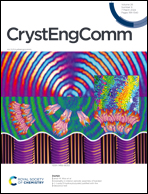Design and synthesis of a turn-off fluorescent sensor based on a multifunctional Zn(ii) coordination polymer for the detection of Fe3+, Hg2+ and 4-nitrophenol†
Abstract
A new π-conjugated bridging-type dicarboxylic acid with a functional alkynyl group, 4,4′-(ethynylimino)bis[benzoic acid] (H2L), was designed and synthesized to construct a Zn(II)-based coordination compound [ZnL(dpa)]n (dpa = 4,4′-dipyridylamine). Compound 1 has two-dimensional layers with alkynyl groups protruding on each side of the layer. The introduction of the ligand dpa ensured the existence of uncoordinated nitrogen atoms. Through Hg⋯C (alkynyl group) and Hg⋯N (amino group) coordination interactions, 1 can effectively detect Hg2+ ions (Ksv = 1.34 × 104 M−1 and LOD = 3.75 × 10−4 mM) by fluorescence quenching. Meanwhile, for Fe3+, in addition to the coordination interactions between Fe3+ ions and the uncoordinated amino groups, competitive absorption was the major contributor to the fluorescence quenching of compound 1. Competitive absorption prompted the sensitive sensing of Fe3+ (Ksv = 3.09 × 104 M−1 and LOD = 1.94 × 10−4 mM) and 4-nitrophenol (Ksv = 7.46 × 104 M−1 and LOD = 4.32 × 10−4 mM).



 Please wait while we load your content...
Please wait while we load your content...